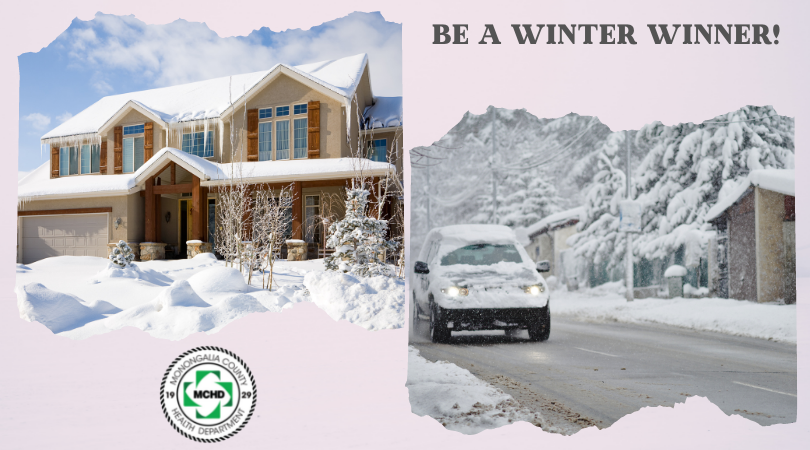Be a winter winner by winterizing your car and home

Jan. 12, 2022
By Katie Minor
Winter arrived late to West Virginia, but last week’s snowstorm finally illustrated why it’s a good idea to be prepared for colder weather, bad road conditions and the illnesses that can pop up or worsen during this time of year.
If you haven’t already, it’s time to prepare your vehicle, your home and your body for any dangers that might lie ahead.
Safety in the car
As West Virginians, we know that rural roads can be very dangerous, especially in the winter. With hidden potholes, perpetual roadwork and erratic deer, it’s important to always stay alert.
But even if you are on the lookout for potential dangers on the road, your efforts could be pointless if your vehicle is unsafe.
Here are a few things you can do to prepare your vehicle for the ice and snow.
- Test your battery. As soon as the temperature drops, so does your car’s battery power. You can get your car battery tested for free at most auto parts stores.
- Check or replace your tires. New tires with a winter tread on them can make a huge difference when driving in dangerous conditions.
- Check or replace your wiper blades. When driving in the snow, the most important thing you can do is see clearly through your windshield. Replacing wiper blades periodically is relatively cheap and easy to do yourself.
I am far from a car safety expert, so these are just a few steps I am going to take to prepare my car for winter. For more helpful tips or for help winterizing your car, click here. There are also knowledgeable people at auto parts stores who can help you find what you need to be safe.
When you find yourself driving in dangerous conditions, like icy roads or heavy snow, there are things you can do at that moment to avoid a crash.
- Avoid cruise control. You always want complete control over your vehicle in the snow or ice.
- If you start skidding, steer in the direction of the skid. This is so that when your wheels regain traction, you won’t have to overcorrect to stay in your lane or avoid a crash.
- Accelerate and decelerate slowly. Doing either of these too quickly can cause your car to start sliding.
- Don’t follow too closely behind other cars. Maintain an eight-10 second following distance so you have time to stop
- Avoid stopping when driving uphill. If the roads are icy, your car can start sliding back down the hill. Avoid stopping unnecessarily to maintain your traction and momentum.
As an anxious driver, sometimes I feel overwhelmed in unsafe driving conditions. It can be hard to remember exactly what to do.
If you’re like me and conditions become very unsafe while you drive, pull over if you can find an off-road location where you can park. Call someone and let them know where you are and what’s going on. Having a friend on the phone can help calm you down.
In case of an emergency, it’s always good to bring your coat, gloves and a fully charged phone when you go out in winter.
One final safety tip for driving is to subscribe to AAA roadside assistance. If you find yourself stranded, you can join AAA right that moment and begin using benefits.
Safety at home
What’s cozier than curling up on the couch with a cup of hot chocolate while snow falls outside? The cold weather and short days — not to mention skyrocketing COVID cases — encourage us to hibernate, so we find ourselves at home more than ever.
Still, intense weather can affect your house, taking away the coziness of home. A No. 1 tip is to observe space heater safety if you must use these devices to warm a room in your home. Remember, 17 people died recently in an apartment fire in the Bronx that has been blamed on a space heater. According to the U.S. Consumer Product Safety Commission, an average of 300 deaths occur annually in this country due to space heaters.
To stay warm and safe inside this winter, here are some tips.
- Insulate windows. The tiniest draft from your windows can make your house feel 10 degrees colder than what your heater’s setting reads. It is actually fairly easy and inexpensive to insulate your windows yourself, using V-seal or rope caulk. For more detailed information on how to insulate your windows, click here.
- Trim tree branches. Avoid a potentially deadly home disaster by keeping your trees trimmed. You shouldn’t only worry about trees falling onto your house; overhanging limbs can drip excess water onto your home and seep inside.
- Inspect your fireplace. A fireplace in the home is the coziest place to be in the winter, but it needs to be in good shape to be able to be fully enjoyed. Before the weather gets too bad, consider conducting an outdoor inspection.
- Check your roof. While you’re up there trimming away tree branches and inspecting your chimney, consider thoroughly inspecting your roof for leaks, missing shingles, etc. A professional inspection might be helpful.
- Clear out gutters. Leaves, branches or water clogged in the gutter and downspouts can damage your home’s foundation. To avoid expensive repairs later on, make sure to clean out your gutters when inspecting your home for winter.
Home is the best place to be in the winter. Make sure you take the right steps to keep it that way!
Katie Minor is a Monongalia County Health Department public information office intern.